DIGITAL MONOCHROME PRINTER
MODEL
P93DW
P93DE
OPERATION MANUAL
BRT/CONT
DOWN
UP
LOCK
FEED
COPY
BRT
CONT
LOCK
OPEN
THIS OPERATION MANUAL IS IMPORTANT
TO YOU.
PLEASE READ IT BEFORE USING YOUR
DIGITAL MONOCHROME PRINTER.
DIGITAL MONOCHROME
PRINTER
This digital monochrome printer complies with the requirements of the EC Directive 89/
336/EEC, 73/23/EEC, 93/42/EEC and 93/68/EEC.
The electro-magnetic susceptibility has been chosen at a level that gains proper
operation in residential areas, on business and light industrial premises and on small-
scale enterprises, inside as well as outside of the buildings. All places of operation are
characterised by their connection to the public low voltage power supply system.
�
FOR THE MODEL P91DW(UB) ONLY
WARNING:
In the USA or Canada, use the AC power cord according to the recommendations as
below, in order to comply with UL2601-1 and CAN/CSA C22.2 No. 601.1.
Case 1. Connect to the 120V receptacle of the room or the host equipment.
The AC power cord should be UL or CSA approved and consist of type SJT, size
16 or 18AWG, length 2.5m or shorter cord with IEC320/C13 type, 125V 10A or
higher rating connector and NEMA 5-15 type, 125V 10A or higher rating, Hospital
Grade plug.
Case 2. Connect to the 230V receptacle of the room or the host equipment.
The AC power cord should be UL or CSA approved and consist of type SJT, size
16 or 18AWG, length 2.5m or shorter cord with IEC320/C13 type, 250V 10A or
higher rating connector and NEMA 6-15 type, 250V 10A or higher rating, Hospital
Grade plug.
Case 3. Connect to the 120V receptacle of the host equipment.
The AC power cord should be UL or CSA approved and consist of type SJT, size
16 or 18AWG, length 2.5m or shorter cord with IEC320/C13 type, 125V 10A or
higher rating connector and IEC320-2.2/E type, 125V 10A or higher rating plug.
Case 4. Connect to the 230V receptacle of the host equipment.
The AC power cord should be UL or CSA approved and consist of type SJT, size
16 or 18AWG, length 2.5m or shorter cord with IEC320/C13 type, 250V 10A or
higher rating connector and IEC320-2.2/E type, 250V 10A or higher rating plug.
CAUTION:
Changes or modifications not expressly approved by the party responsible
for compliance could void the user’s authority to operate the equipment.
NOTE:
This equipment has been tested and found to comply with the limits for a
Class A digital device, pursuant to Part 15 of the FCC Rules.
These limits are designed to provide reasonable protection against
harmful interference when the equipment is operated in a commercial
environment. This equipment generates, uses, and can radiate radio
frequency energy and, if not installed and used in accordance with the
instruction manual, may cause harmful interference to radio communica-
tions.
Operation of this equipment in a residential area is likely to cause harmful
interference in which case the user will be required to correct the interfer-
ence at his or her own expense.
Information:
This class A digital apparatus complies with Canadian ICES-003.
"CLASSIFIED BY UNDERWRITERS LABORATORIES INC.®
WITH RESPECT TO ELECTRIC SHOCK, FIRE AND MECHANICAL HAZARDS ONLY IN
ACCORDANCE WITH UL2601-1 AND CAN/CSA C22.2 No. 601.1"
�
CAUTION:
RISK OF ELECTRIC SHOCK DO NOT OPEN.
TO REDUCE THE RISK OF ELECTRIC SHOCK,DO NOT REMOVE COVER (OR
BACK)
NO USER-SERVICEABLE PARTS INSIDE. REFER SERVICING TO QUALIFIED
SERVICE PERSONNEL.
The lightning flash with arrowhead symbol, within an equilateral triangle, is
intended to alert the user to the presence of uninsulated "dangerous voltage"
within the product's enclosure that may be of sufficient magnitude to constitute a
risk of electric shock.
The exclamation point within an equilateral triangle is intended to alert the user
to the presence of important operating and maintenance (servicing) instructions
in the literature accompanying the appliance.
The “Caution, hot surface” symbol indicates that the marked item may be hot
and should not be touched.
The “ON/OFF” symbol indicates connection to or disconnection from the mains,
at least for mains switches.
The “Equipotentiality” symbol identifies the terminals connected each other. The
potential of various parts of equipment or of a system is equalized.
The “Alternating current” symbol indicates that the equipment is suitable for
alternating current only.
When you dispose of the unit or accessories, you must obey the law in the relative area
or country and/or regulation in the relative hospital.
�
WARNING:
Install and use this appliance in accordance with the operation manual for safety and
EMC (Electromagnetic Compatibility). If it is not installed and used in accordance with
the operation manual, it may cause interference to other equipment and/or other risk.
To prevent fire or shock hazard, do not expose this appliance to rain or moisture.
This appliance must be earthed.
In Europe, use the AC power cord according to the recommendations as below, in order
to comply with EN60601-1 and EN60950.
Connect to the 230V receptacle of the room or the host equipment.
The AC power cord should be VDE approved and consist of core size 1mm2 or bigger,
length 2.5m or shorter cord with IEC320/C13 type, 250V 10A or higher rating connector
and CEE(7)VII type or IEC 320-2.2/E type, 250V 10A or higher rating plug.
Use the USB cable according to the recommendations as below, in order to comply with
EN60601-1-2.
The USB cable with appropriate plug should be 2 m long or shorter, comply with USB 2.0
standard High speed requirements and USB IF (USB Implementers Forum) approved.
This product is to be employed with medical equipment, just for reference purpose, not
for medical diagnostic purpose.
�
INSTRUCTIONS FOR MEDICAL USE
MEDICAL ELECTRICAL EQUIPMENT needs special precautions regarding EMC and needs
to be installed and put into service according to the EMC information provided in the AC-
COMPANYING DOCUMENTS.
Portable and mobile RF communications equipment can affect MEDICAL ELECTRICAL
EQUIPMENT.
Technical description
List of all cables and maximum length of the cable and transducers and other
ACCECCORIES
Maximum length
Reference page in this operation manual
AC power cord
2.5 m
This page, the previous pages for safety and page 22
for accessories
USB cable
2 m
This page, the previous pages for safety and page 22
for accessories
Thermal paper
Page 3 for thermal paper, Page 22 for accessories
WARNING:
The use of ACCESSORIES, transducers and cables other than those specified, with the
exception of transducers and cables sold by the manufacturer of the Model P93DW/P93DE
as replacement parts for internal components, may result in increased EMISSIONS or
decreased IMMUNITY of the Model P93DW/P93DE.
WARNING:
The Model P93DW/P93DE should not be used adjacent to or stacked with other equipment
and that if adjacent or stacked use is necessary, the Model P93DW/P93DE should be
observed to verify normal operation in the configuration in which it will be used.
�Guidance and manufacturer's declaration - electromagnetic emissions
The Model P93DW/P93DE is intended for use in the electromagnetic environment specified below.
The customer or user of the Model P93DW/P93DE should assure that it is used in such an
environment.
Emission test
RF emissions
CISPR 11/EN 55011
Compliance
Group 1
RF emissions
CISPR 11/EN 55011
Harmonic emissions
IEC/EN 61000-3-2
Voltage fluctuations /
flicker emissions
IEC/EN 61000-3-3
Class B
Class A
Complies
Electromagnetic environment - guidance
The Model P93DW/P93DE uses RF energy only for its
internal function. Therefore, its RF emissions are very
low and are not likely to cause interference in nearby
electronic equipment.
The Model P93DW/P93DE is suitable for use in all
establishments, including domestic establishments
and those directly connected to public low-voltage
power supply network that supplies buildings used for
domestic purpose.
Guidance and manufacturer's declaration - electromagnetic immunity
The Model P93DW/P93DE is intended for use in the electromagnetic environment specified below.
The customer or user of the Model P93DW/P93DE should assure that it is used in such an
environment.
IEC/EN 60601
test level
±6 kV contact
±8 kV air
Compliance
level
±6 kV contact
±8 kV air
Electromagnetic environment - guidance
Floors should be wood, concrete or
ceramic tile. If floors are covered with
synthetic material, the relative humidity
should be at least 30%.
Mains power quality should be that of a
typical commercial or hospital
environment.
Mains power quality should be that of a
typical commercial or hospital
environment.
Mains power quality should be that of a
typical commercial or hospital
environment. If the user of the Model
P93DW/P93DE requires continued
operation during power mains
interruptions, it is recommended that the
Model P93DW/P93DE be powered from
an uninterruptible power supply or a
battery.
Immunity test
Electrostatic
discharge (ESD)
IEC/EN 61000-4-2
Electrical fast
transient/burst
IEC/EN 61000-4-4
Surge
IEC/EN 61000-4-5
Voltage dips, short
interruptions and
voltage variations
on power supply
input lines
IEC/EN 61000-4-11
±2 kV for power
supply lines
±1 kV for input
/output lines
±1 kV
differential
mode
±2 kV common
mode
< 5% UT
(> 95% dip in UT)
for 0,5 cycle
40% UT
(60% dip in UT)
for 5 cycles
70% UT
(30% dip in UT)
for 25 cycles
< 5% UT
(> 95% dip in UT)
for 5 sec.
3 A/m
±2 kV for power
supply lines
±1 kV for input
/output lines
±1 kV
differential
mode
±2 kV common
mode
< 5% UT
(> 95% dip in UT)
for 0,5 cycle
40% UT
(60% dip in UT)
for 5 cycles
70% UT
(30% dip in UT)
for 25 cycles
< 5% UT
(> 95% dip in UT)
for 5 sec.
3 A/m
Power frequency
(50/60 Hz)
magnetic field
IEC/EN 61000-4-8
NOTE UT is the a.c. mains voltage prior to application of the test level.
Power frequency magnetic fields should
be at levels characteristic of a typical
commercial or hospital environment.
�
Guidance and manufacturer's declaration - electromagnetic immunity
The Model P93DW/P93DE is intended for use in the electromagnetic environment specified below.
The customer or user of the Model P93DW/P93DE should assure that it is used in such an
environment.
Immunity test
IEC/EN 60601
test level
Compliance
level
Conducted RF
IEC/EN 61000-4-6
Radiated RF
IEC/EN 61000-4-3
3 Vrms
150 kHz to 80
MHz
3 V/m
80 MHz to 2,5
GHz
3 Vrms
3 V/m
Electromagnetic environment - guidance
Portable and mobile RF communications
equipment should be used no closer to
any part of the Model P93DW/P93DE,
including cables, than the recommended
separation distance calculated from the
equation applicable to frequency of the
transmitter.
Recommended separation distance
d=1,2√P
d=1,2√P 80 MHz to 800 MHz
d=2,3√P 800 MHz to 2,5 GHz
where P is the maximum output power
rating of the transmitter in watts (W)
according to the transmitter manufacturer
and d is the recommended separation
distance in meters (m).
Field strengths from fixed RF
transmitters, as determined by an
electromagnetic site survey,a should be
less than the compliance level in each
frequency range.b
Interference may occur in the vicinity of
equipment marked with the following
symbol:
NOTE1. At 80 MHz and 800 MHz, the higher frequency range applies.
NOTE2. These guidelines may not apply in all situations. Electromagnetic propagation is
affected by absorption and reflection from structures, objects and people.
a
Field strengths from fixed transmitters, such as base stations for radio (cellular/cordless)
telephones and land mobile radios, amateur radio, AM and FM radio broadcast and TV
broadcast cannot be predicted theoretically with accuracy. To assess the electromagnetic
environment due to fixed RF transmitters, an electromagnetic site survey should be
considered. If the measured field strength in the location in which the Model P93DW/P93DE
is used exceeds the applicable RF compliance level above, the Model P93DW/P93DE
should be observed to verify normal operation. If abnormal performance is observed,
additional measures may be necessary, such as reorienting or relocating the Model
P93DW/P93DE.
b Over the frequency range 150 kHz to 80 MHz, field strength should be less than 3 V/m.
�
Recommended separation distances between
Portable and mobile RF communications equipment and the Model P93DW/P93DE
The Model P93DW/P93DE is intended for use in the electromagnetic environment in which
radiated RF disturbances are controlled. The customer or user of the Model P93DW/P93DE can
help prevent electromagnetic interference by maintaining a minimum distance between portable
and mobile RF communications equipment (transmitters) and the Model P93DW/P93DE as
recommended below, according to the maximum output power of the communications equipment.
Rated maximum output
Separation distance according to frequency of transmitter
power of transmitter
m
W
0,01
0,1
1
10
100
150 kHz to 80 MHz
d=1,2√P
80 MHz to 800 MHz
d=1,2√P
800 MHz to 2,5 GHz
d=2,3√P
0,12
0,38
1,2
3,8
12
0,12
0,38
1,2
3,8
12
0,23
0,73
2,3
7,3
23
For transmitters rated at maximum output power not listed above, the recommended separation
distance d in meters (m) can be estimated using the equation applicable to the frequency of the
transmitter, where P is the maximum output power rating of the transmitter in watts (W)
according to the transmitter manufacturer.
NOTE1. At 80 MHz and 800 MHz, the separation distance for higher frequency range applies.
NOTE2. These guidelines may not apply in all situations. Electromagnetic propagation is
affected by absorption and reflection from structures, objects and people.
�
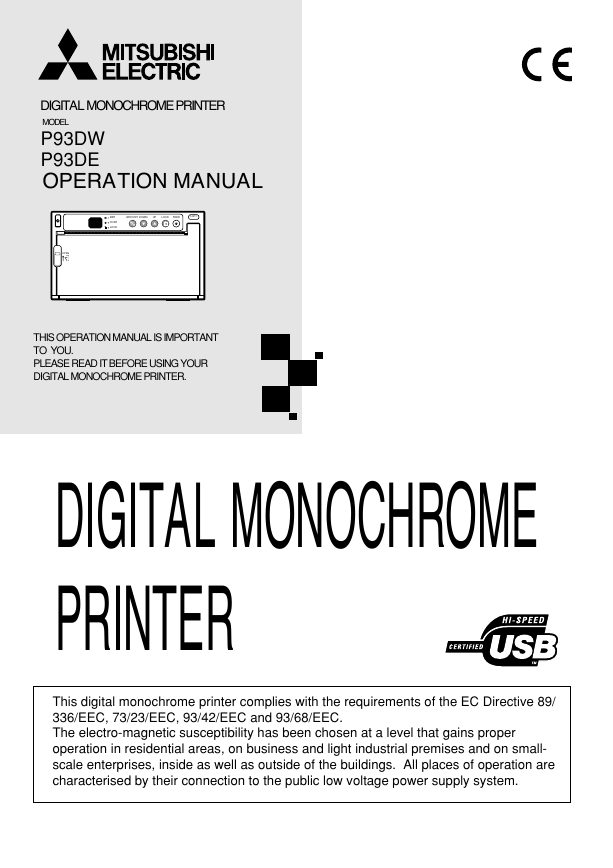

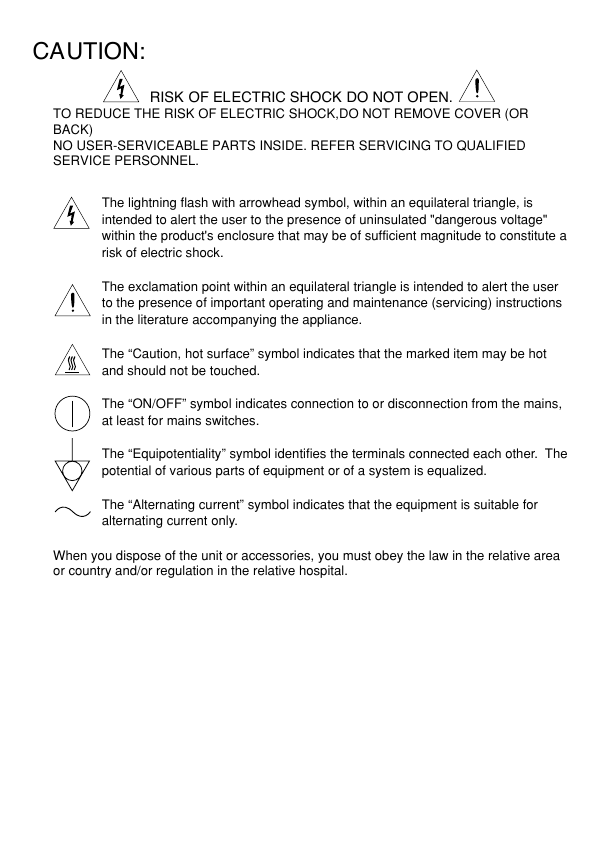

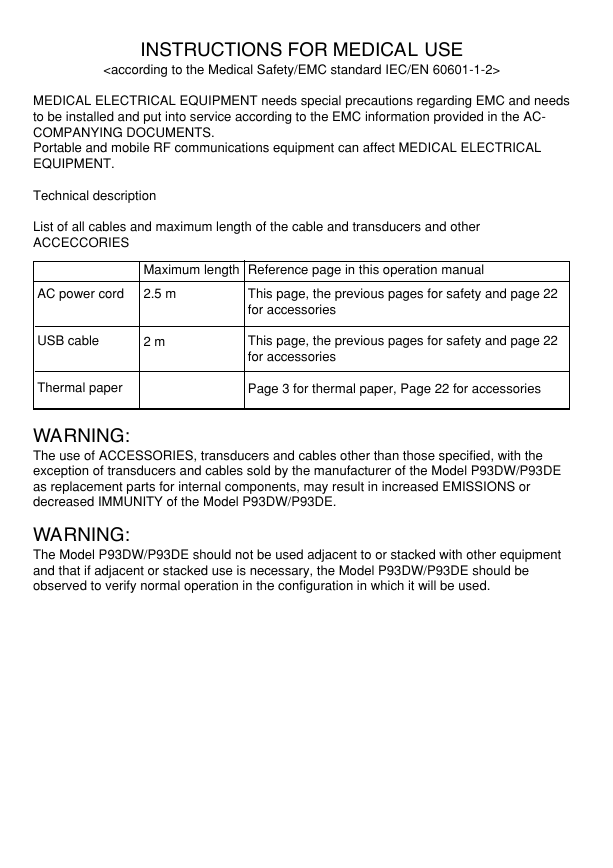

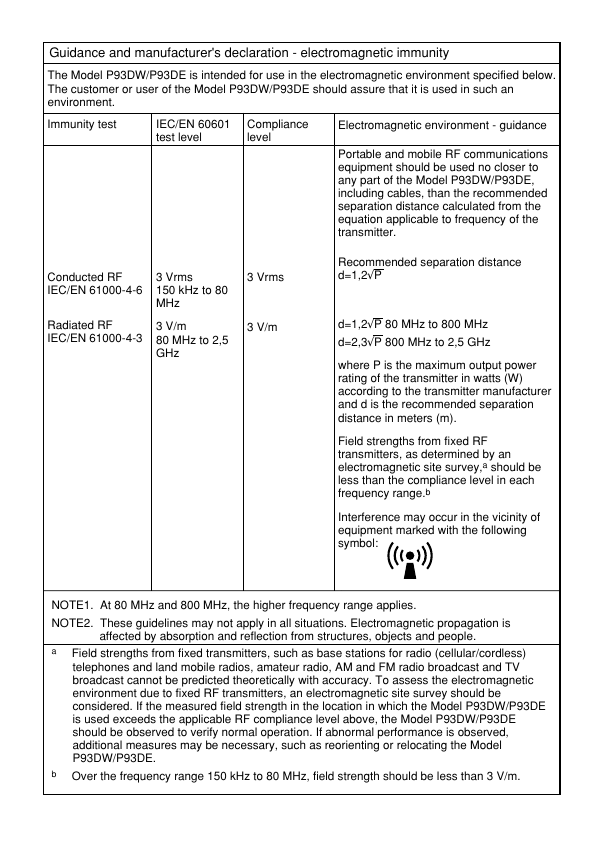
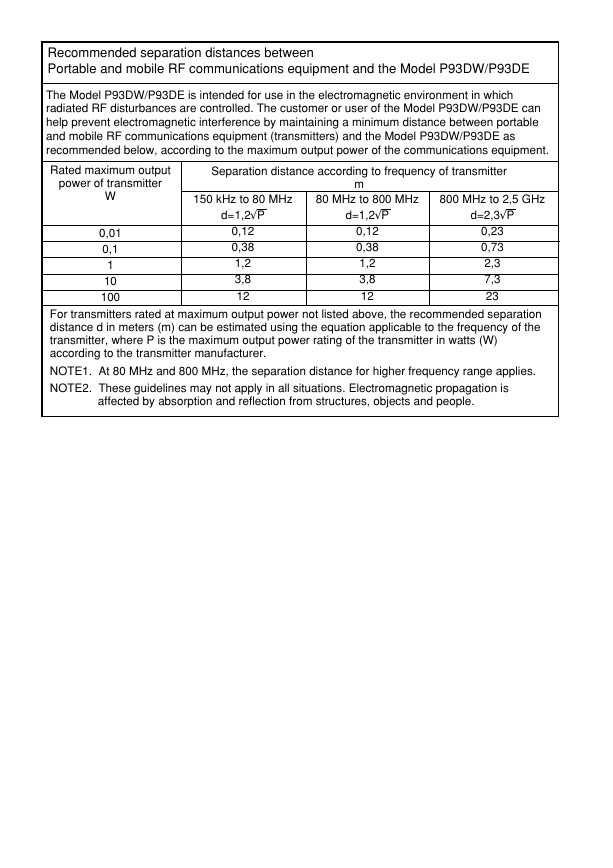








 2023年江西萍乡中考道德与法治真题及答案.doc
2023年江西萍乡中考道德与法治真题及答案.doc 2012年重庆南川中考生物真题及答案.doc
2012年重庆南川中考生物真题及答案.doc 2013年江西师范大学地理学综合及文艺理论基础考研真题.doc
2013年江西师范大学地理学综合及文艺理论基础考研真题.doc 2020年四川甘孜小升初语文真题及答案I卷.doc
2020年四川甘孜小升初语文真题及答案I卷.doc 2020年注册岩土工程师专业基础考试真题及答案.doc
2020年注册岩土工程师专业基础考试真题及答案.doc 2023-2024学年福建省厦门市九年级上学期数学月考试题及答案.doc
2023-2024学年福建省厦门市九年级上学期数学月考试题及答案.doc 2021-2022学年辽宁省沈阳市大东区九年级上学期语文期末试题及答案.doc
2021-2022学年辽宁省沈阳市大东区九年级上学期语文期末试题及答案.doc 2022-2023学年北京东城区初三第一学期物理期末试卷及答案.doc
2022-2023学年北京东城区初三第一学期物理期末试卷及答案.doc 2018上半年江西教师资格初中地理学科知识与教学能力真题及答案.doc
2018上半年江西教师资格初中地理学科知识与教学能力真题及答案.doc 2012年河北国家公务员申论考试真题及答案-省级.doc
2012年河北国家公务员申论考试真题及答案-省级.doc 2020-2021学年江苏省扬州市江都区邵樊片九年级上学期数学第一次质量检测试题及答案.doc
2020-2021学年江苏省扬州市江都区邵樊片九年级上学期数学第一次质量检测试题及答案.doc 2022下半年黑龙江教师资格证中学综合素质真题及答案.doc
2022下半年黑龙江教师资格证中学综合素质真题及答案.doc